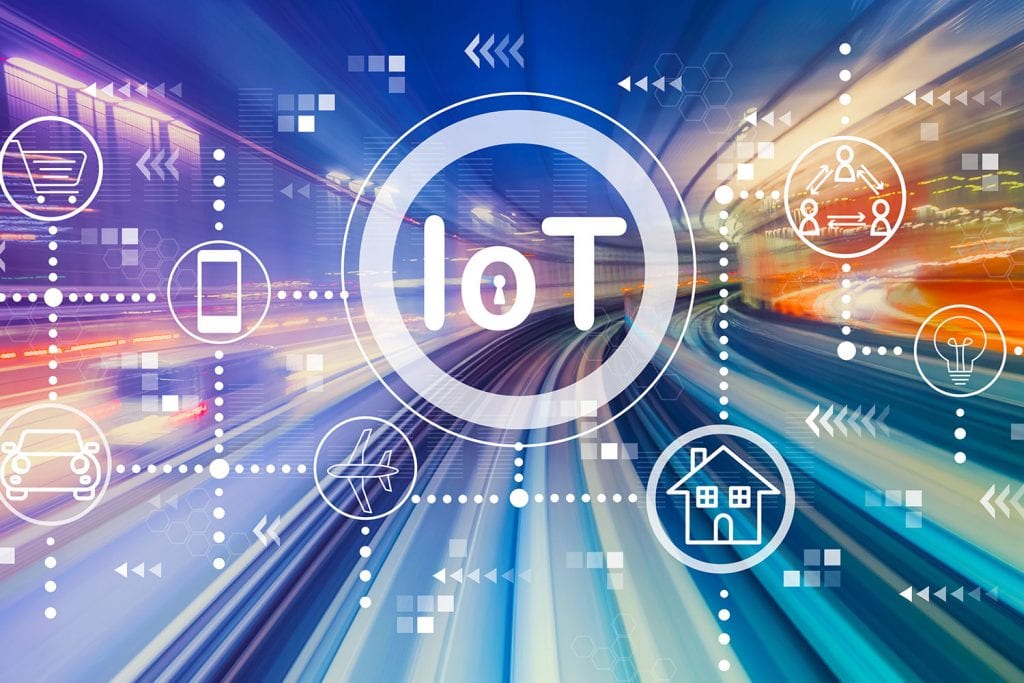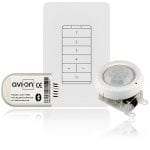Helpful IoT Terms & Definitions
Helpful IoT Terms & Definitions
The Internet of Things (IoT) is the connectivity of physical objects such as vehicles, devices, buildings, and electronics, and the networks that allow them to interact, collect and exchange data.
6LOWPAN
An acronym that combines the latest version of the Internet Protocol (IPv6) and Low-power Wireless Personal Area Networks (LoWPAN). 6LoWPAN is a protocol that allows power constrained IoT devices to access the TCP/IP internet directly.
Helpful tip: 6LoWPAN allows for the smallest devices with limited processing ability to transmit information directly to the internet with a battery life that lasts for years.
ADVANCED ENCRYPTION STANDARD (AES)
Electronic data encryption specification, established in 2001, operating on a public/private key system. Planning for key management is important when implementing AES.
Helpful tip: To date, there are no known successful practical attacks having allowed illicit access of correctly implemented AES encrypted data. This is the standard for transport layer security in IoT devices.
APPLICATION PROGRAMMING INTERFACE (API)A way for computers to talk to hardware or software platforms in a less complicated way.
Helpful tip: Third parties use other company’s API platforms as a point of integration. Designing applications to leverage APIs allows for faster development and easier paths to improve over time.
BACKHAUL
Backhaul refers to the process of reporting event information from tagged assets related to things like movement, temperature, distress and so forth.
Helpful tip: This process can easily become very data- and resource-intensive, substantially raising the cost of ownership for IoT devices.
BIG DATA
A very large set of data that can be analyzed for patterns and trends. Big data provides valuable (and very profitable) insights that can be used to identify service or product opportunities and customer behaviors.
Helpful tip: Analyzing big data moves enterprises away from making decisions by gut instinct into data-drive strategic choices. IoT deices have the potential to generate entirely new streams of data for big data processing.
BLUETOOTH LOW ENERGY (BLE)
Also known as Bluetooth 4.0, this is a wireless, personal-area network with short-range and low-power consumption that allows for objects to transmit data.
Helpful tip: This technology offers low-cost, safe, wireless connectivity and solves many of the earlier Bluetooth’s pairing and performance headaches. This is the least expensive way to add short range wireless connectivity to devices.
CLOUD COMPUTING
“In the cloud” refers to a network of remote servers hosted online that store, manage, and process data.
Helpful tip: Cloud computing is vital for large sets of data. It’s great for those who need disaster recovery, collaboration controls, security, and an environmentally friendly way to store data
EMBEDDED SOFTWARE
Instruction code that runs on hardware microcontrollers. Usually it is performing specific low-level functions, often without using an operating system.
Helpful tip: Specialized for the particular hardware it runs on, embedded software often has time and memory constraints which must be addressed in IoT innovation. Most IoT devices leverage embedded software which can take longer to write than more abstracted server-side code.
FIRMWARE OVER-THE-AIR (FOTA)
A mobile technology enabling manufacturers to wirelessly repair bugs or remotely install new software, features, and services on a mobile device after product distribution.
Helpful tip: FOTA is an efficient way to upgrade and update a mobile device wirelessly. Manufacturers can save resources on efficient and timely upgrades without having physical access to the device.
GATEWAY
A device that receives information from many other points on the network and transmits information to another network.
Helpful tip: When multiple wireless protocols are mixed, a gateway is almost always required. The gateway is the stopping point for online communications, the hub through which data is sent back and forth.
GENERAL PACKET RADIO SERVICE (GPRS)
A wireless communications standard on 2G and 3G cellular networks supporting a number of bandwidths and providing data rates of 56-114 kbps.
Helpful tip: As cellular companies move to more advanced networks, GPRS networks may be more cost-effective for IoT networks. NB-IoT and LTE-M1 networks are being touted as replacements for these older cellular standards.
INDUSTRIAL IOT (IIOT)
M2M communication for machinery and other industrial applications.
Helpful tip: The IIoT enables machinery and equipment to transmit real-time information to an application. This allows operators to better understand equipment efficiency and identify preventative maintenance needs.
INDUSTRIAL, SCIENTIFIC, AND MEDICAL (ISM) BAND
An unlicensed part of the RF spectrum used for general purpose data communications. In the US, the ISM bands are 915MHz, 2.4 GHz, and 5.5 GHz, whereas 2.4 GHz is the global unlicensed frequency, and has increasing amounts of interference.
Helpful tip: This part of the radio spectrum can be used without a license in most countries.
LINK BUDGET
An accounting of all of the losses (e.g. from antennas, structural attenuation, propagation loss) in a wireless communication system.
Helpful tip: In order to “close the link,” enough RF energy has to make it from the transmitter to the receiver.
LOW-POWER WIDE AREA (LPWA)
LPWA networks are built specifically for M2M communications and offer long-range, low-power consumption.
Helpful tip: LPWANs solve cost and battery life issues that cellular technology cannot, and solve range issues that technologies like Bluetooth or BLE struggle with.
LOW-POWER WIRELESS SENSOR NETWORK
A group of spatially distributed, independent devices that collect data by measuring physical or environmental conditions with minimal power consumption.
Helpful tip: Minimizing power consumption is key to achieving a longer lifetime for devices on wireless sensor networks.
LORA PROTOCOL (LORAWAN)
A LPWAN specification deployed internally to enable IoT and M2M, intended for carrier networks of wireless, battery-operated things.
Helpful tip: Many carriers are testing LoRaWAN as a possible technology to support IoT networks.
LTE-M
An abbreviation for LTE-MTC (or machine-type communications), LTE-M is a more energy efficient part of the LTE system. Because of its extended discontinuous repetition cycle (eDRX) an endpoint can communicate with the tower or network on how often it will wake up to listen for the downlink.
Helpful tip: LTE-M is one of three new standards, along with NB-IoT, from the cellular industry allowing devices that operate on carrier networks to be less expensive and more power efficient.
MACHINE TO MACHINE (M2M)
Connected devices exchanging information with other connected devices, without human assistance.
Helpful tip: Machines monitoring other machines, without the need of human intervention, are transforming many industries. For example, a machine can alert when a new part is needed or broken down, eliminating manual monitoring, which eats up valuable time and resources.
MEDIA ACCESS CONTROL (MAC)
One of two sublayers in a network, the MAC address is a unique identifier allowing the physical medium (radio waves or wire signals) to be organized to pass data back and forth.
Helpful tip: Upper layer protocols rely on the MAC layer to produce complex, functioning networks.
MOTE
Primarily used in North America, this is one way of referring to an “endpoint” in the IoT. Also known as a node, this usually refers to a generic sensor out in the physical world.
Helpful tip: The sensor does the data gathering, some processing and communicated with other connected nodes in the IoT network.
NB-IOT
Even simpler than NB-LTE-M, this is a proposed narrowband (NB) technology not based on LTE. Instead it will likely be deployed on a side band or in deprecated GSM spectrum.
Helpful tip: Although not available yet, with chipsets (if they exist) in the prototype stage, this may be an inexpensive option when rolled out.
NEAR-FIELD COMMUNICATION (NFC)
Low-power, low-speed, short-range radio communication standard that allows two-way communication between endpoints within very close proximity.
Helpful tip: Popular as a contactless communication between mobile devices, NFC is used to send information without physical device connection.
QUALITY OF SERVICE (QOS)
QoS manages network capabilities and resources to provide a reliable backbone to IoT connectivity. In order to offer secure and predictable services, QoS can manage delays, bandwidth and packet loss by classifying traffic and registering channel limits.
Helpful tip: With effective QoS management in place, there is a much better chance of receiving warnings or other high priority messages in near real-time.
RADIOFREQUENCY (RF)
Radio waves. This term generally means “wireless communication” when referred to in IoT discussions.
Helpful tip: RF is fundamental to IoT connectivity. Many IoT devices have RF transceiver chipsets to transmit data long distances using minimal power.
RADIO FREQUENCY IDENTIFICATION (RFID)
Generally speaking, this is the use of strong radio waves to “excite” enough current in a small tag to send a radio transmission back. It works over short range, and only for small amounts of data.
Helpful tip: RFID tags can be used to detect and record such as temperature, movement, radiation levels, and thus can be very useful in asset monitoring and supply chain management.
RF GEOLOCATION
A general term that applies to “finding” a radio transceiver with another — GPS is a good example.
Helpful tip: Location is a critical part of many IoT solutions. For systems that have GPS, location is easy. When GPS doesn’t work for cost or because the node is indoors, WiFi fingerprinting or BLE proximity can be used.
REPEATER
A device that receives and retransmits a digital signal to extend network reach.
Helpful tip: Repeaters boost the distance a signal can travel and help a transmitted communication overcome obstructions.
SMART METER
An electronic device that collects data about consumption of energy (gas, electric) and communicates it back to the energy company and/or consumer.
Helpful tip: Enabling two-way communication, smart meters gather and transmit IoT device information to the central network.
SOFTWARE-DEFINED NETWORK (SDN)
An approach to networking that decouples control of information flow from the hardware and gives it to a software controller.
Helpful tip: This allows for less data to travel wirelessly, making it a potential strategy for IoT networks.
STRUCTURE ATTENUATION
The loss in intensity of radio waves through a medium (like radio waves through a brick wall).
Helpful tip: Structure attenuation can slow data transmission in the IoT. Repeaters can be used to address this issue.
TRANSMISSION CONTROL PROTOCOL/INTERNET PROTOCOL (TCP/IP)
The core standard protocol for internet-based communications. Some wireless systems “break” TCP/IP in order to lower the overhead of the on-air signals.
Helpful tip: This protocol manages data packets at the TCP layer and handles addressing of those packets at the IP layer. With this protocol, gateways can recognize and route data.
ULTRA-WIDE BAND (UWB)
A “spark gap” transmitter that emits a very weak, very wide (in frequency) pulse of RF energy. This signal is used mostly for localizing signals. Wide signal bandwidths are good for measuring distance.
Helpful tip: UWB operates by generating short, narrow pulses and can be an attractive option for asset tracking and fleet/inventory management.
ZIGBEE/Z-WAVE
Short-range, low-power wireless standards used for sensing and control, typically used for personal or home area networks, or in a wireless mesh for longer-range networks. Like 6LoWPAN, designed for low data-rate and battery-powered applications, but Zigbee and Z-Wave technology can require more nodes to function successfully — which can increase costs.








Recent Comments